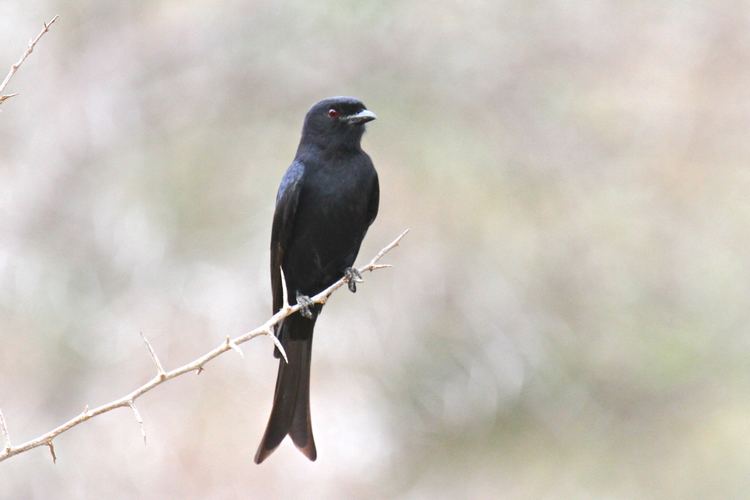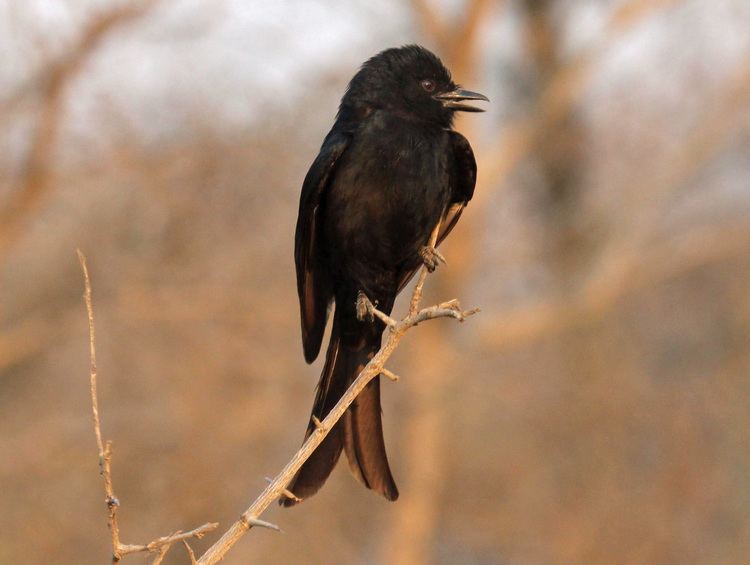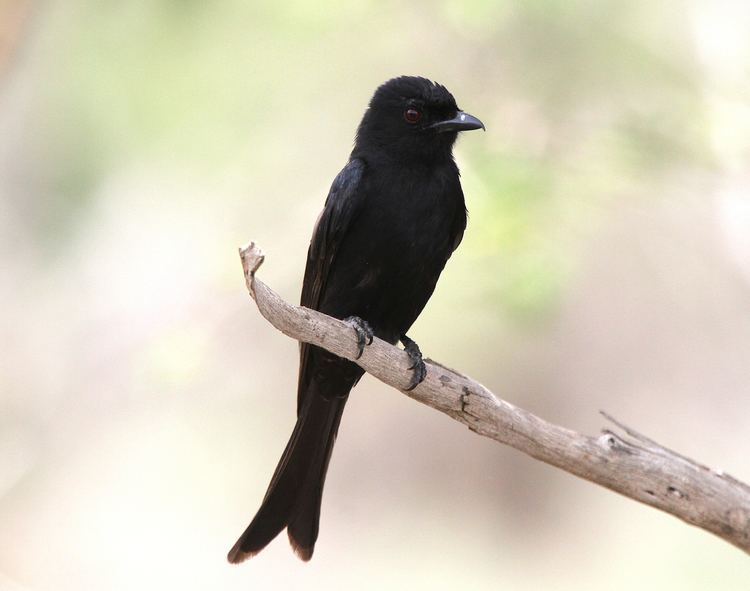Order Passeriformes Genus Dicrurus Higher classification Dicrurus | Phylum Chordata Family Dicruridae Scientific name Dicrurus adsimilis Rank Species | |
 | ||
Similar Drongo, Bird, Red‑eyed dove, Southern fiscal, Black‑headed heron | ||
Bird for identification fork tailed drongo
The fork-tailed drongo, also called the common drongo, African drongo, or savanna drongo (Dicrurus adsimilis), is a species of drongo in the family Dicruridae, which are medium-sized passerine birds of the Old World. It is native to the tropics, subtropics and temperate zones of the Afrotropics. Its range was formerly considered to include Asia, but the Asian species is now called the black drongo (Dicrurus macrocercus).
Contents
- Bird for identification fork tailed drongo
- Fork tailed drongo filmed by greg morgan
- Range and habitat
- Description
- Calls
- Behavior
- Feeding
- Kleptoparasitism
- Nesting
- Races
- References

Fork tailed drongo filmed by greg morgan
Range and habitat

The fork-tailed drongo is a common and widespread resident breeder in Africa south of the Sahara. These insect-eating birds are usually found in open forests or bush, and are tolerant of arid climates.
Description

The fork-tailed drongo is 25 cm long and has short legs. Males are mainly glossy black, although their wings are duller. Females are similar but less glossy. It is large-headed with well-developed rictal and nasal bristles, which are used as sensory organs. The rectrices curve outwards, forming the forked tail for which the species is named. The hooked bill is black and heavy, and the eye is red.
Calls

The call is a metallic strink-strink. The fork-tailed drongo in Africa are capable of using deceptive mimicked alarm calls to steal food from birds and animals such as meerkats. Vocal at dawn and dusk.
Behavior
They still-hunt by sitting very upright on a prominent perch, much like a shrike. They are usually solitary and form monogamous breeding pairs. They are aggressive and fearless, regularly mobbing or attacking much larger species, including birds of prey, if their nest or young are threatened or their territory is compromised. They also join mixed foraging bird parties, and will initiate mobbing of common enemies. To maintain their plumage condition they may rain-bathe, foliage-bathe or plunge-dive into water. Terrestrial foragers like babblers may use the drongo as a sentry.
Feeding
They are almost exclusively carnivorous, but may take nectar when available. They flycatch or take prey from the ground, and are attracted to bush fires. They also utilize disturbance caused by animals, and may perch on their backs. At times they catch ectoparasites on mammals, plunge-dive to catch fish, or kleptoparasitise mammals or birds.
Kleptoparasitism
Observations show that the fork-tailed drongo in Africa are capable of using deceptive mimicked alarm calls to steal food from birds like pied babblers and animals such as meerkats. Tom Flower observed that fork-tailed drongos spend a quarter of their time following other animals. Drongos sometimes act as sentries when a predator is approaching, warning their neighbours with genuine alarm calls. But drongos also earn a quarter of their daily calories by sounding a false alarm when another animal finds food. When the meerkats and babblers flee from the non-existent predator, the drongo steals their food. Though in doubt, researchers have considered the possibility that these drongos possess theory of mind, not fully shown in any animal other than humans.
Nesting
Two to four eggs are laid in a cup nest in a fork high in a tree. The African cuckoo exclusively parasitizes this species.
Races
Its populations are genetically highly structured, and four races are accepted. The races D. a. modestus (Príncipe) together with D. a. coracinus and D. a. atactus (Bioko to west and central mainland Africa, from Guinea east to western Kenya and south to Angola) are usually split as a separate species, the velvet-mantled drongo, D. modestus (Hartlaub, 1849).
